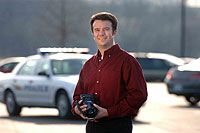I have a great job! I travel around the world training and educating law enforcement personnel on the benefits of thermal imaging and its many applications. I meet lots of interesting people, and I have the opportunity to get “down in the trenches” with many of America’s finest. This job has exposed me to officers ranging from large US Government departments to smaller, more rural departments that employ just a few officers. I believe I gain more than I leave behind, and I thoroughly enjoy the face-to-face contact with the many different people who can be found in the law enforcement community.
 At the beginning of every class, I always ask two questions: Who has had exposure to thermal imaging, and where did that exposure come from? Inevitably, one or two officers have had some exposure; equally predictably, that exposure came, in some way, from the fire service.
At the beginning of every class, I always ask two questions: Who has had exposure to thermal imaging, and where did that exposure come from? Inevitably, one or two officers have had some exposure; equally predictably, that exposure came, in some way, from the fire service.
Let me be the first to come right out and say it: firefighters are in the thermal imaging game for an entirely different reason than police officers. When firefighters think thermal imaging, they think HEAT. A firefighter always has that picture of a structure fire in his head, and thermal imaging quickly evolves into heat imaging; however, with law enforcement, we want thermal imaging to remain thermal imaging.
In law enforcement we need to stick to the idea that colder and warmer are equally important. Law enforcement operations typically occur in an ambient temperature range, a more normal range where small temperature differences are important. This is the temperature difference between a piece of evidence and the grass in which it lies, not large thermal events that the fire service imagines. In law enforcement operations, we’re not concerned about “heat signatures” or “heat measurement;" we’re concerned about what is thermally visible.
With this usage difference in mind, Bullard engineers created the TacSight series of thermal imagers. TacSight is not a fire imager wrapped in a black package; rather it is a thermal imager designed specifically for law enforcement use, but with the same outward design and durability to which the fire service has become accustomed.
A fire service imager works best when it is operating above 300°F. This is where the greatest image detail is found. Below this temperature, the image is adjusted to produce a picture that will appear the same at ambient temperatures as it does in fire conditions. It is because of this feature that a fire service imager can “see” well into the 1,000°F range. The tradeoff is a slight loss of detail and an increase in signal noise at ambient temperatures. This is true for all fire service imagers, regardless of manufacturer.
TacSight was designed so that its sweet spot is found at ambient temperatures. It creates its clearest, cleanest, most detailed image at normal, environmental temperature ranges. This means that TacSight can easily detect warm objects (people can be detected at over 1,000 feet), but it can also resolve the thermal difference between a cinder block and the mortar that binds it. This level of sensitivity is only possible in a law enforcement imager; however, it comes packaged in a water tight, dust-proof, impact resistant housing that protects it from whatever you can dish out. No longer will the imager need to be locked in a protective case and secured in the captain’s office only to be used when the situation warrants; rather, portability and durability have brought that product to the front line where it can serve its ultimate purpose, which is to make the job of the police officer easier and much safer.
Hopefully, at some point in my travels, our paths will cross. If they do, please introduce yourself. Share a story, ask a question, whatever. Meeting the men and women who walk the line every day is my favorite part of what I do. In the meantime, I will continue to travel, educate, train and evangelize this technology in an effort to tip the odds back in your favor. Remember, you should never seek a level playing field; rather, the playing field upon which you ply your craft should always be tipped in your favor; as soon as it is level, the bad guys will cheat in an attempt to win. They will always play outside the rules. It is what makes them criminals in the first place. With this in mind, we are always seeking new technologies with which to gain the upper hand. After all, bad guys don’t play fair…why should you?









